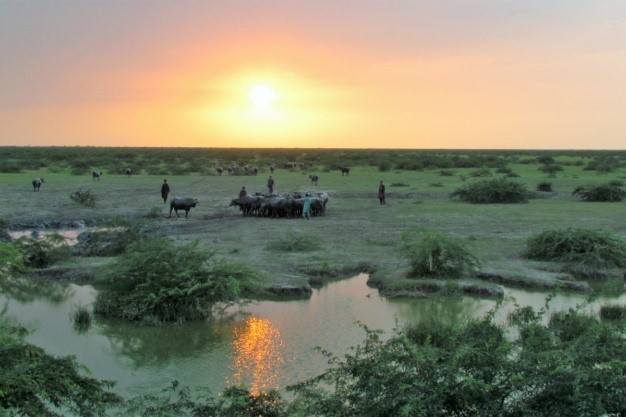Description

Disclaimer: Copyright infringement not intended.
Context
- Centre approved setting up cheetah breeding centre in Banni Grassland in Kutch.
READ ALL ABOUT BANNI GRASSLANDS: https://www.deccanherald.com/india/gujarat/centre-approves-setting-up-cheetah-breeding-centre-in-banni-grassland-in-kutch-2803744
Banni Grasslands Reserve
- Banni Grasslands Reserve or Banni grasslands form a belt of arid grassland ecosystem on the outer southern edge of the desert of the marshy salt flats of Rann of Kutch in Kutch District, Gujarat State.
- The Banni region was created by the 1819 earthquake.
- The land here was formed from the sediments that were deposited by the Indus and other rivers over thousands of years.
- They are known for rich wildlife and biodiversity and are spread across an area of 3,847 square kilometres.
- They are currently legally protected under the status as a protected or reserve forest in India.
- The Wildlife Institute of India (WII) has identified this grassland reserve as one of the last remaining habitats of the cheetah in India and a possible reintroduction site for the species.
Vegetation
- Vegetation in Banni is sparse and highly dependent on year-to-year variations in rainfall.
- Banni is dominated by low-growing forbs and graminoids, many of which are halophiles (salt tolerant), as well scattered tree cover and scrub. The tree cover is primarily composed of Salvadora spp. and the invasive Prosopis juliflora.
- Dominant species include Cressa cretica, Cyperus spp., grasses in the genera Sporobolus, Dichanthium, and Aristida.

Wildlife
- The grasslands are home to mammals such as the nilgai (Boselaphus tragocamelus), chinkara (Gazella bennettii), blackbuck (Antilope cervicapra), wild boar (Sus scrofa), golden jackal (Canis aureus), Indian hare (Lepus nigricollis), Indian wolf (Canis lupus pallipes), caracal (Caracal caracal), Asiatic wildcat (Felis silvestris ornata) and desert fox (Vulpes vulpes pusilla) etc. among others.
- The last Indian wild ass (Equus hemionus khur) population, which had become confined to nearby Little Rann of Kutch, has been increasing in numbers since 1976 and has recently started spilling over into adjoining areas including Greater Rann of Kutch, Banni and the adjoining villages of the neighbouring Indian state of Rajasthan.
- Banni grasslands also have a rich diversity of avifauna, herpetofauna and invertebrates.
- During good rainfall years the seasonal water bodies of Banni form important staging grounds for thousands of flamingos, migratory cranes and also support large numbers of over 150 species of migratory and resident birds.
|
PRACTICE QUESTION
Q. Consider the following statements with reference to Banni grasslands:
1.The Banni region was created by the 1819 earthquake.
2.The land here was formed from the sediments that were deposited by the Indus and other rivers over thousands of years.
3.This grassland reserve as one of the last remaining habitats of the cheetah in India and a possible reintroduction site for the species.
Which of the above statements is/are incorrect?
A) 1 only
B) 2 and 3 only
C) All
D) None
Answer: D) None
|












